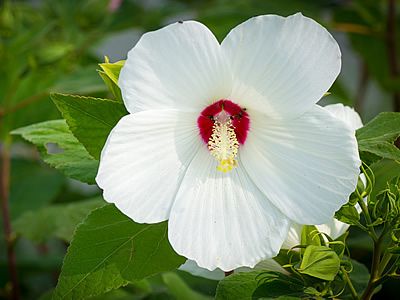The Swamp Rose Mallow (Hibiscus moscheutos) is a species of shrub-like stature and ornamental flowering, native to the flooded plains along the Atlantic Ocean coast in North America. It features branched foliage with a semi-herbaceous and erect texture. The leaves are mucilaginous, pubescent on the underside, and glabrous on the upper side. They can be entire or have up to three lobes, and are generally presented in deltoid or cordate shapes, with crenate margins.
It flowers in the summer, producing large terminal flowers with diameters ranging from 6 to 10 inches (15 to 25 cm), depending on the cultivar. The flowers are pentamerous, hermaphroditic, and come in a wide variety of colors such as white, salmon, pink, red, and wine, in solid colors or in delicate gradients, many of them with a brown or burgundy center. The fruits are globular capsules, containing numerous seeds.

In landscaping, the Swamp Rose Mallow is suitable for creating masses, borders, or groupings. Its shrubby structure makes it an excellent low hedge or border plant. It is ideal for marshy lands or wetland areas, around fountains and small ponds.
It adapts very well to coastal regions, subject to sea spray. It brings the tropical vibe of hibiscus to cooler locales as well. Can be planted in pots or planters. Attractive to butterflies and hummingbirds.
Swamp Rose Mallow should be cultivated in full sun, in sandy or clay soil, enriched with organic matter and kept constantly moist or frequently irrigated. This hibiscus species loses its foliage in harsh winters but usually regrows vigorously in the spring.
Fertilize in the spring and summer with fertilizers suitable for growth and flowering. Propagation can be done by sowing seeds in a moist substrate in spring, by cuttings, or by dividing the rooted branches during the winter.


